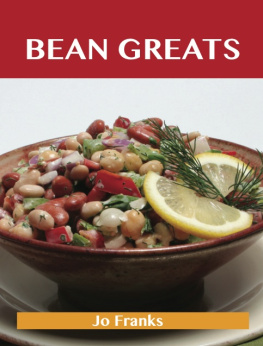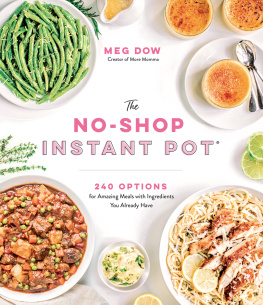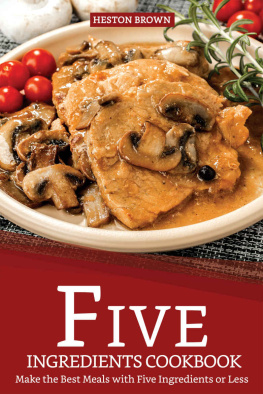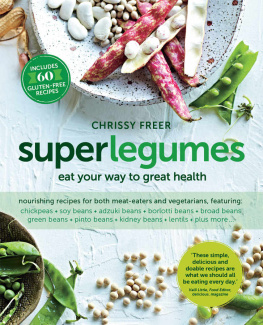


Contents
How to Use This Ebook
Select one of the chapters from the and you will be taken straight to that chapter.
Alternatively, jump to the to browse recipes by ingredient.
Look out for linked text (which is blue) throughout the ebook that you can select to help you navigate between related sections.
You can double tap images to increase their size. To return to the original view, just tap the cross in the top left-hand corner of the screen.
INTRODUCTION
The storecupboard is a wondrous thing; I am always dipping in, whether to begin a meal, to embellish one or to create an entire dish. Within the storecupboard you will always find the humble tin cheap, nutritious and long lasting. This book showcases these versatile creatures and gives you all sorts of new ideas on how to use them.
You can pick up a tin of tomatoes or tuna almost anywhere. The tin is universal, affordable and accessible. No need for snobbery: the tin is an undervalued resource. Every recipe in this book has something tinned at its core; from black beans to sardines or pears, each is the springboard for a quick, easy and delicious meal. Tinned food shouldnt be bland or dull; I hope to show you how to create new and exciting dishes from familiar tinned foods and introduce you to some lesser-used tinned friends-to-be.
Take One Tin is for people who want to inject some oomph into their Wednesday dinner, reinvent those storecupboard essentials and be introduced to some more unfamiliar ingredients that are just sitting on the shelf waiting to be discovered. Whether youre after a restorative breakfast or a yummy pudding, youll find perfect recipes here all (pretty much) from the comfort of the tinned aisle.
The bulk of the ingredients used in support of the mighty tin are also from the storecupboard, meaning each recipe can be made without a shopping list as long as your arm; many recipes in the book have 10 ingredients or fewer. Storecupboard staples are topped up with fresh ingredients that can easily be found in most shops.
Youll notice that there isnt any meat in this book. I am no vegetarian, but I do see the importance of eating less meat for both environmental and health reasons. It has been great to get creative with vegetables, pulses and fish and not look to meat to be the centre of any dish. Of course, meat could be added to many of the dishes in this book, but I think they hold their own as they are. Hopefully youll agree.

The chapters have been arranged to showcase the range of tins available, beginning with the staple that is beans and pulses. I am a true worshiper of the pulse. Tomatoes and vegetables come next, which play a central role in countless dishes. The book then goes on to the fish section, where I think you will be surprised at the range of delicious and affordable dishes you can make. The fruit and sweet tins chapter was heavily inspired by summers spent plodding about on my parents allotment, helping them harvest, then watching them cooking and preserving their hauls of berries, pears and peaches. This chapter showcases the amazing tinned fruit you can get all year round, as well as things to make from storecupboard staples, like coconut milk. The final chapter provides you with a few tasty accompaniments to eat alongside your meal, all very simple and made using ingredients that are predominantly from your storecupboard.
A couple of practical bits: the oven temperatures are written for fan ovens; to convert to non-fan, simply add 20C. There are a few recipes that either require or benefit from a stick blender or electric beaters; they are both great, small and cheap pieces of kit to have in your kitchen.
I hope this book helps you see how accessible, achievable and often even joyous cooking can be and to realise that it doesnt always need to be about fresh or expensive ingredients. My wish for this book is that it leads you to the conclusion that the tin is a wondrous thing.



Spiced cannellini beans on toast
Who doesnt love baked beans? These are a homemade alternative, sweet, spicy and warming. Top with a fried egg for a classic breakfast.
SERVES 2
1 tablespoon olive oil
1 garlic clove, finely chopped
teaspoon chilli flakes
pinch of paprika
400g tin plum tomatoes
2 teaspoons Worcestershire sauce
1 teaspoon soft brown sugar
2 teaspoons cider vinegar
400g tin cannellini beans, drained and rinsed
salt and freshly ground black pepper
2 slices of bread
Heat the olive oil in a large frying pan over a low-medium heat. Once warm, add the garlic, fry until starting to turn golden, then add the spices and cook for a further 30 seconds. Tip in the plum tomatoes, Worcestershire sauce, sugar, vinegar and cannellini beans. Season, bring to the boil, then simmer on a medium-high heat for 1520 minutes until slightly thickened.
Toast your bread and serve piled high with the beans, topped with a fried egg, if you like.

Green lentil fritters
These are perfect for a lazy weekend brunch, try them with a fried egg. Beetroot can be swapped for parsnip or carrot (or pretty much any root veg).
SERVES 2 (ABOUT 68 FRITTERS)
400g tin green lentils, drained and rinsed
70g plain flour
1 egg, beaten
3 tablespoons chopped chives
1 teaspoon caraway seeds
1 teaspoons paprika
1 garlic clove, finely chopped
200g raw beetroot, peeled and coarsely grated
12 tablespoons flavourless oil (such as sunflower)
salt and freshly ground black pepper
TO SERVE
1 teaspoon harissa
2 tablespoons natural yogurt
Mix together the lentils, flour, egg, chives, caraway seeds, paprika, garlic and beetroot, and then season.
Warm the oil in a large frying pan over a medium heat. For each fritter, dollop in a heaped tablespoon of mixture, flatten slightly and fry until golden (about 4 minutes per side). If they start to colour too soon, turn the heat down to low.
Meanwhile, mix the harissa into the yogurt.
Serve the fritters with a generous spoonful of the harissa yogurt.

Next page


















